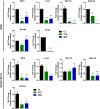Scorpion (Hottentotta tamulus) venom pre-exposure delays functional recovery in mice following peripheral nerve injury
- PMID: 40828807
- PMCID: PMC12364329
- DOI: 10.1371/journal.pone.0330600
Scorpion (Hottentotta tamulus) venom pre-exposure delays functional recovery in mice following peripheral nerve injury
Abstract
Scorpion sting leads to profound challenges of central nervous system (CNS) impairments such as neuro-inflammation, unconsciousness, aberrant ion channels physiology, epilepsy and may become fatal due to heart failure. However persistence of Hottentotta tamulus venom in peripheral nerves and subsequent influence on regenerative process of injured peripheral nerve remains unknown. Current study reports the persistence of H. tamulus venom components 30-days following its intraperitoneal administration in sciatic nerves (SN) of mice pre-exposed through either a single-toxin exposure (STE) or multiple-toxin exposure (MTE). Of note, venom pre-exposure delays and compromises the sensori-motor functional recovery in STE and MTE mice following standard sciatic nerve crush injury. Histological investigations of regenerating SN and gastrocnemius muscles (GCM) 14-days post crush injury exhibited reduced myelination and limited numbers of motor axons in SNs and GCM of MTE mice, respectively. Consistently, a marked reduction in expression of regeneration-promoting markers including transcription factors (such as Atf-3 and c-Jun), regeneration associated genes (such as Sprr1a and Gap-43) and ion channel proteins encoding genes (such as Scn9a and Kcc2) was observed in lumber dorsal root ganglia (DRG) and regenerating SN 14-days post crush injury. Collectively, this study reports the persistence and regeneration-inhibiting effects of H. tamulus venom in peripheral nerve of pre-exposed mice leading to compromised functional recovery.
Copyright: © 2025 Khan et al. This is an open access article distributed under the terms of the Creative Commons Attribution License, which permits unrestricted use, distribution, and reproduction in any medium, provided the original author and source are credited.
Conflict of interest statement
Authors do not have any financial or other competing interests.
Figures



Similar articles
-
MSC-derived mitochondria promote axonal regeneration via Atf3 gene up-regulation by ROS induced DNA double strand breaks at transcription initiation region.Cell Commun Signal. 2024 Apr 25;22(1):240. doi: 10.1186/s12964-024-01617-7. Cell Commun Signal. 2024. PMID: 38664711 Free PMC article.
-
AT-rich interaction domain 5A facilitates axon regeneration through docking protein 6 in the peripheral nervous system.Burns Trauma. 2025 Feb 10;13:tkaf012. doi: 10.1093/burnst/tkaf012. eCollection 2025. Burns Trauma. 2025. PMID: 40568374 Free PMC article.
-
Prescription of Controlled Substances: Benefits and Risks.2025 Jul 6. In: StatPearls [Internet]. Treasure Island (FL): StatPearls Publishing; 2025 Jan–. 2025 Jul 6. In: StatPearls [Internet]. Treasure Island (FL): StatPearls Publishing; 2025 Jan–. PMID: 30726003 Free Books & Documents.
-
Management of urinary stones by experts in stone disease (ESD 2025).Arch Ital Urol Androl. 2025 Jun 30;97(2):14085. doi: 10.4081/aiua.2025.14085. Epub 2025 Jun 30. Arch Ital Urol Androl. 2025. PMID: 40583613 Review.
-
Dietary Approaches to Stop Hypertension (DASH) for the primary and secondary prevention of cardiovascular diseases.Cochrane Database Syst Rev. 2025 May 6;5(5):CD013729. doi: 10.1002/14651858.CD013729.pub2. Cochrane Database Syst Rev. 2025. PMID: 40326569 Review.
References
LinkOut - more resources
Full Text Sources
Research Materials
Miscellaneous

